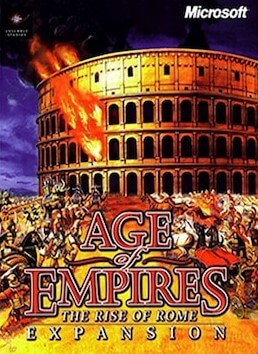Empire Earth: The Art of Conquest is the expansion pack for the real-time strategy game Empire Earth. Art of Conquest was developed by Mad Doc Software, and was released on September 17, 2002 in the United States. The game was released in Europe later in the year, and the following year in Japan. The Gold Edition of Empire Earth, which features both the original and the expansion, was released on May 6, 2003.
Art of Conquest added several new features to the original Empire Earth, including units, civilizations (Japan and Korea), civilization powers, and hero units. Art of Conquest also features three new campaigns: Ancient Rome, World War II, and 24th century Mars. The game received mixed reviews, averaging 66% on GameRankings.
Gameplay
See also: Empire Earth § Gameplay
The gameplay in Art of Conquest is the same as in the original Empire Earth, albeit with some changes. Variable difficulty has been added to those scenarios which had not received it in a patch of the original Empire Earth. Online multiplayer capabilities has been added, allowing players to play online with up to seven other players either over the Internet via a lobby system, or over a local area network (LAN).citation needed
The new Space Age (Epoch XV) allows the building of spaceports and spaceships on maps that allow it. Robots replace Citizens in the Nano Age and infantry in the Space Age (these robots are known as Watchmen). Nano age Farms are run by robots, and by the Space Age farms no longer need citizens to manage them. Each civilization has its own power, or "Civ Power". Often, these powers are only available during certain epochs. A Civ Power gives each nation a specialty: the Chinese, for example, have the "just-in-time manufacturing" ability; while the Japanese have the "cyber ninja" ability.
Empire Earth supports multiplayer over LAN connections and online. Multiplayer games are identical in form to single-player games. Art of Conquest multiplayer play has many exploits, which players can use to give themselves an unfair advantage. The game's publisher, Vivendi Games, has set up forums where players can report exploits. The multiplayer servers were taken offline on November 1, 2008; players are only able to play through local area network and Direct IP.
Campaigns
Three new campaigns were added in The Art of Conquest: an Ancient Roman campaign about Gaius Marius and Julius Caesar, a campaign involving the warfare in the Pacific Ocean during World War II, and a futuristic Asian campaign involving the colonization of Mars.
Roman Campaign
The Roman campaign revolves around the struggles of Marius and the conquests of Julius Caesar. The campaign comprises six distinct scenarios.
The first scenario begins in the late Roman Republic. The player, as Gaius Marius, can conscript citizens and must defeat the combined threat of a Teutonic horde and a Cimbri invasion force into Italy in 102-101 BC.
The second scenario moves the story into an alternate reality where Gaius Marius must flee from Lucius Cornelius Sulla into Carthage and then defeat Jugurthian bandits in order to gain the support of the Carthaginian Senate (War elephants and naval transport ships). Afterwards, the player must achieve victory by killing Sulla's loyal senators and liberating Rome from his Dictatorship.
The third scenario covers Caesar's exile into Greece and Asia Minor where he gets help avoiding capture from Greek bounty hunters by a Pirate King on Crete. In Asia Minor he must help the King of Bythnia against rebels who have taken over Mytilene in Lesbos. The scenario ends with a showdown against Sulla's eastern Legion in Thracia.
The fourth scenario depicts Julius Caesar's conquest of Gaul and the invasion of Britain. The player starts in the Roman province of Hispania (modern Spain). There he must collect and deliver a large amount of resources within a certain time in order to pay Marcus Crassus for his support in Rome while fighting off local barbarians. The scenario continues with the migrating Helvetii trying to aggressively settle down in Hispania by crossing the Pyrenees mountains. After defeating the Helvetti, the player must lead his army into Gaul and subdue the various Gallic tribes, including the Ambrones, Belgians, and Suebi. Then, he must cross the English Channel and defeat the Celts in Britain.
The fifth scenario follows Caesar's war with his former ally and friend Pompey. This scenario starts with the famous crossing of the Rubicon, his conquest of Italy, and the short Greek campaign which ends at the battle of Pharsalus.
The final scenario details his conquest of Ptolemaic Egypt, where he must choose which side to help; Cleopatra VII or Ptolemy XIV. Both have differing objectives and situations:
Helping Cleopatra VII gives Caesar control of the large city of Alexandria, where he starts in. He must then hold off Ptolemy XIV's forces and prevent them from capturing town centers inside the city while trying to destroy Ptolemy's desert camps outside the city.
Helping Ptolemy XIV is dangerous as Caesar and his army must move quickly to escape from Alexandria or risk being overwhelmed by Cleopatra's forces. He must then regroup outside in one of Ptolemy's camps in the desert and then capture the Town Centers inside the city in order to achieve victory.
If the player chooses to help Cleopatra, Ptolemy will (after a certain amount of time) send soldiers towards the Great Pyramid of Cheops and try to make it lose half its hitpoints. If they succeed, the player is defeated and must then load a saved game (although a script bug allows the player to destroy the pyramid by simply selecting it and pressing delete without being defeated, thus permanently preventing Ptolemy from damaging an already destroyed building).

















